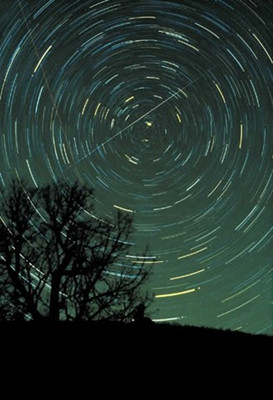On a previous show we mentioned how not all shooting stars have the same speed.
前面的文章中我們提到為什么不是所有流星都有相同的速度。
Some disappear almost immediately, while others make a nice slow line across the sky.
有些幾乎立即就消失了,而有些拖著長長的尾巴穿過天空。
If you enjoy watching the slow ones, there is a way of upping your chances of seeing them.
如果你喜歡觀看緩慢的流星,那么有一種方法可以增加你看到它們的幾率。
Go out just after sunset.
日落后就出門。
That's because the slowest meteors come in the evening and the fastest ones come in the morning, just before sunrise.
最慢的流星在夜晚出現(xiàn),最快的流星出現(xiàn)在早晨,就在太陽升起之前。
Can you guess why?
你猜猜為什么呢?

The speeds of meteors we see are increased or decreased by the earth's motion.
我們看到的流星的運動速度隨著地球的運動情況而增減。
If we charge into them head-on our speed is added to their speed.
如果地球正對著流星的方向運動,那么我們的運速就會增加至它的運動速度中。
If, on the other hand, we aremoving away from them, our speed is subtracted from their speed.
反之,如果我們背向它們運動,那么它們的運速中就會減去地球運速這一部分。
Now imagine yourself standing at the north pole, facing the direction the earth is moving through space.
現(xiàn)在想想你自己站在北極,面向地球穿過空間移動的方向。
You rise up magically, far enough away that you can see the whole planet rotating underneath you while you yourself remain stationary.
你奇跡般地上升,遠(yuǎn)到可以看到整個地球在你的腳下轉(zhuǎn)動,而你自己保持靜止。
Which direction is it turning?
它是在向哪個方向運動呢?
Counterclockwise. Where is thesunlight?
逆時針。太陽光在哪里呢?
From your perspective, it's on the left side of the planet.
從你的角度來看,在地球的左側(cè)。
That means that the front of the planet, or the part that's charging into oncoming meteors, is the placewhere morning is beginning for people on earth.
這意味著在地球的前端,或者是在正對流星運動的地方,就是早晨的開始。
The back of the planet, meaning the part that's movingaway from meteors, is where evening is beginning.
地球的背面,也就是背向流星運動的地方,就是夜晚的開始。
It may seem funny, but every morning when you look up into the sky, you are looking in the same direction as the planet is moving.
這似乎非常有趣,但是每天早晨當(dāng)你仰望天空時,你就是望著與地球轉(zhuǎn)動相同的方向。
In the evening you are looking the other way.
晚上,你就是望著相反的方向。
And the speed ofshooting stars confirms it!
流星的速度證實了這一點。











